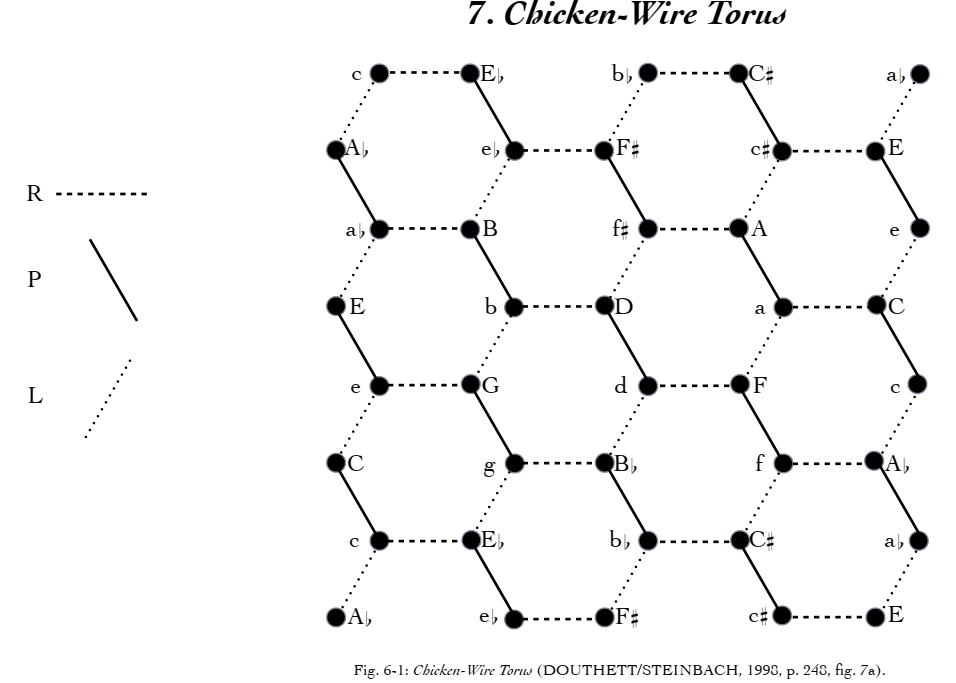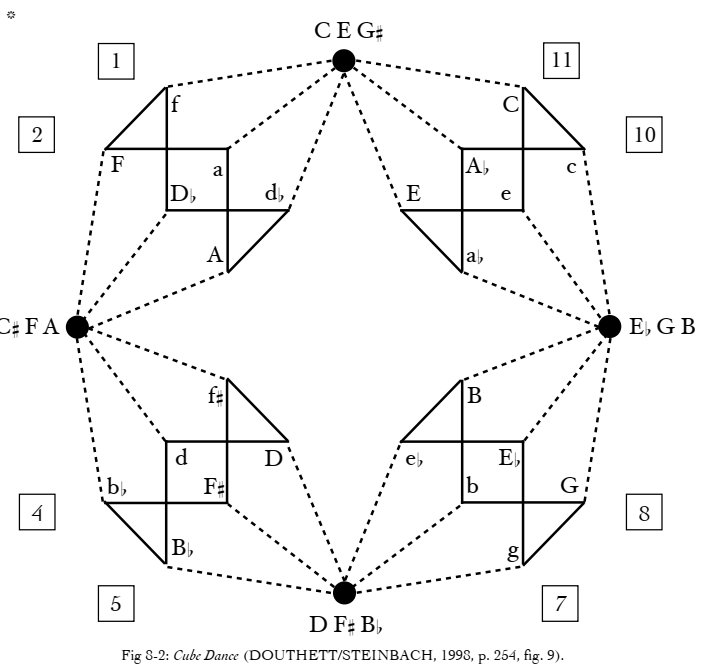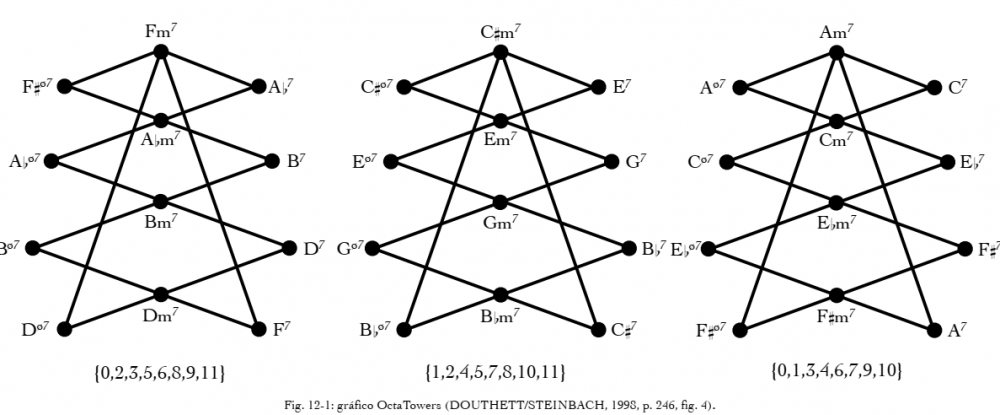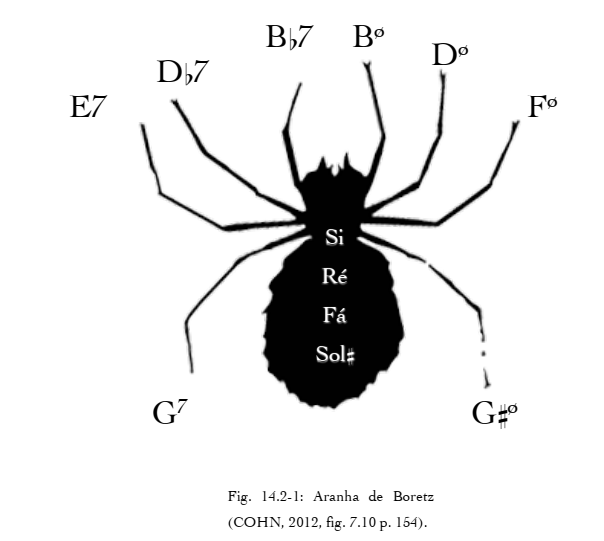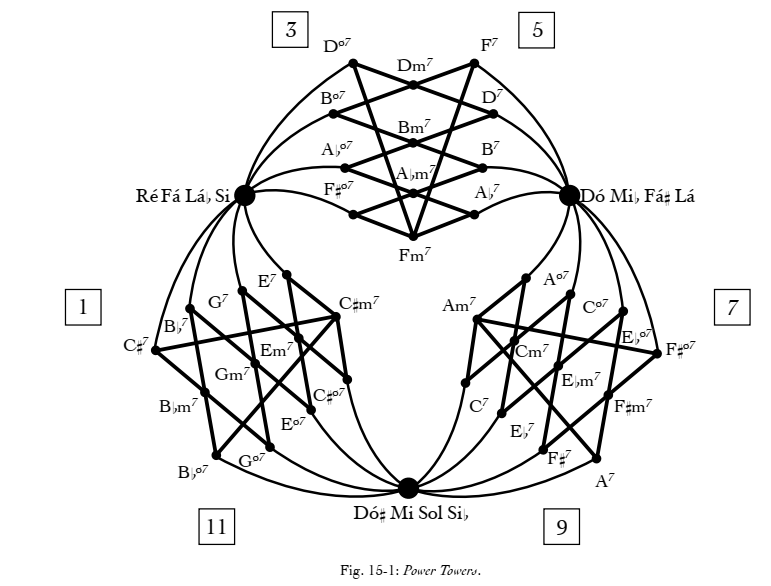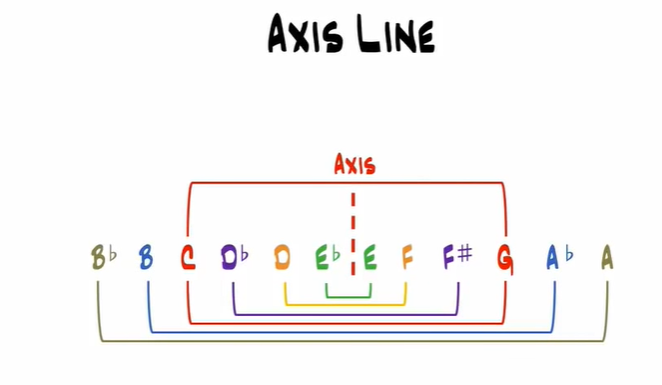-
Posts
839 -
Joined
-
Last visited
Content Type
Forums
Events
Store
Video Gallery
Everything posted by JulioHerrlein
-

Neo-Riemannian approach (Tonnetz, etc.)
JulioHerrlein replied to Wim Dijkgraaf's topic in Function Examples
Dear Janusz, This is a really cool feature I was looking for ! There is a lot of interesting transformations and graphs related to this subject, like this, compiled by my friend Ciro Visconti, who studied with Straus: THE FAMOUS "CUBE DANCE" PARSIMONIOUS TRANSFORMATIONS OF 4-NOTE CHORDS BORETZ SPIDER POWER TOWERS And so on, all related to the basic tonnetz transformations. A good idea is thinking how to model also four note structures. All the best ! Julio -

Bizarre hanging on function gen-sieve (probably loop)
JulioHerrlein replied to JulioHerrlein's topic in Function Examples
Yes, like looping. Thanks. Yes, thank you. -
Finally I had success !! Thank you. My old .gig VSL have the keyswitches in the C1 octave, instead of C2. I had to edit the files you provided. Best, Julio
- 27 replies
-
- programs
- def-sound-set
-
(and 2 more)
Tagged with:
-
;; MATERIAL (setf mat1 '((e d4 stacc gs4 stacc e5 stacc - - pizz a4 - pizz cs4 marc d4 -) (-s - - - gs4 leg e5 a4 pizz cs4 d4 ord) (-s - marc gs4 e5 stacc a4 cs4 d4 pizz - -) (s gs4 - - e5 - a4 cs4 d4 -) (-s d3 - - eb3 d3 - a3))) (setf violin1 (ambitus 'violin (pitch-transpose 12 mat1))) (setf violin2 (ambitus 'violin (gen-retrograde (pitch-transpose 7 mat1)))) (setf viola (ambitus 'viola (gen-rotate -3 (pitch-transpose -5 mat1)))) (setf violoncello (ambitus 'violoncello (gen-rotate 0 (pitch-transpose -12 mat1)))) (setf ts (get-time-signature violin1)) ;;--------------------------------------------------------- ;; SCORE and LAYOUT ;;--------------------------------------------------------- (def-score string-quartet (:title "String Quartet" :composer "acme" :copyright "test VSL artic" :key-signature 'chromatic :time-signature ts :tempo 100 :layout (string-quartet-layout 'violin1 'violin2 'viola 'violoncello)) (violin1 :omn violin1 :port 0 :channel 1 :sound 'vi-violin :program 0 :volume 100 :pan 44 :controllers (91 '(48)) ) (violin2 :omn violin2 :port 0 :channel 2 :sound 'vi-violin :program 0 :volume 100 :pan 54 :controllers (91 '(48)) ) (viola :omn viola :port 0 :channel 5 :sound 'vi-viola :program 0 :volume 90 :pan 74 :controllers (91 '(60)) ) (violoncello :omn violoncello :port 0 :channel 7 :sound 'vi-cello :program 0 :volume 90 :pan 84 :controllers (91 '(60)) ) ) (init-seed nil) My last unsuccessful try, with DEF-SCORE. Same as above: right channel, right port, right sounds, no keyswitches. Best, Julio
- 27 replies
-
- programs
- def-sound-set
-
(and 2 more)
Tagged with:
-
Dear Janusz, The articulation control work with the ps function (preview score) ? Or just in def-score ? In ps function I´m not getting the keyswitches to work. Everything worked fine, the channels, the port and it´s sending to the right place. Just no keyswitches. Best, Julio
- 27 replies
-
- programs
- def-sound-set
-
(and 2 more)
Tagged with:
-
Thanks, Janusz This is handy when you want to use the simple sounds of computer motherboard. Best, Julio
- 27 replies
-
- programs
- def-sound-set
-
(and 2 more)
Tagged with:
-
Thanks, Janusz ! Looks very clear ! I´ll try it. Best ! Julio
- 27 replies
-
- programs
- def-sound-set
-
(and 2 more)
Tagged with:
-
Dear Janusz, 1) I copied the Cello with keyswitch you provided above to the folder you provided. 2) I edited the string quartet in my custom instrument file, like this: I put the VSL-Cello inside the layout... (is it wrong ?) ;; STRING QUARTET LAYOUT - PORT 0 :sq (:layout string-quartet-layout :port 0 :channel '(13 14 15 16) :sound 'gm :program '(violin violin viola VSL-Cello) :controllers nil :pan (pan '(-30 -10 10 30)) :volume 92) I got this error: Error: #<sound-set #x3020009F987D> has no program named: vsl-cello > While executing: get-sound-set-program, in process Listener-1(7). > Type cmd-. to abort, cmd-\ for a list of available restarts. > Type :? for other options. Help, please ! Best, Julio
- 27 replies
-
- programs
- def-sound-set
-
(and 2 more)
Tagged with:
-
Thanks, Janusz. Best !
- 27 replies
-
- programs
- def-sound-set
-
(and 2 more)
Tagged with:
-
Dear Janusz, I really need a more detailed example, for getting there. I'm understanting this way: 1) There is a file with customized score layouts that probably do a "call out" of this instrument definition table and also midi ports (this point I think I got). I put my custom instrument setup in the folder /Users/acmevm/Documents/Opusmodus/Def-Libraries/Def-Instrument-Sets. But this settings are more related to ports and channels, not articulation. There is no informations about keyswitches here. But it worked for changin the port and channels. 2) There must be a place where we put the instrument setup like the Cello with keyswitches you provided, i.e, a file where we can define how the specific instruments of teh custom setup behave and works (if it have or not keyswitches, etc). Each brand have some specific stuff. I don't know where to put the new Cello with keyswitches lisp file in order to call it out later in the OMN expression. 3) The third thing is an instruction for how Opusmodus treat the articulation inside the OMN expression, i.e., how the OMN expression integrated with the notation triggers the keyswitching in an actual score. And also a secondary question: will it works just on def-score expression (and not in the PS function) ? 4) Last, is the building of expression that change or not change the keyswitching (notation versus sound control independently). I nice idea would be you provide a little but complete in terms of the technical stuff example (just 3 or 4 bars of music, with changing keyswitches in OMN expression) with all we need to run it. It's a little complex setup, I see. Maybe a video tutorial. I would love to make a video tutorial, as soon as I understand the thing... But I'm not getting there yet. Best, Julio
- 27 replies
-
- programs
- def-sound-set
-
(and 2 more)
Tagged with:
-
There is a sound-set (VSL) document that is close to what I'm looking, with detailed description of the articulation. I think that there is also a filter for selecting articulations according to the length of the notes. Is it correct ? This would be handy. But do I have to copy that parameters in every score I do, or it functions in the background ? Thank you. Best, Julio Thank you, Janusz The VSL example you provided have keyswitches. Nice. Almost there. The VSL Cello lisp file contained in Opusmodus package is in the folder inside opusmodus package and looks like this (without keyswitches). (in-package :Opusmodus) ;;;--------------------------------------------------------- ;;; VIENNA INSTRUMENTS - VIOLONCELLO SOLO ;;;--------------------------------------------------------- ;; Patches, keyswitches and controllers change events. (def-sound-set VSL-Cello-Solo :programs (:group short ;stacc (cc12 0 cc13 0) detache-short (cc12 0 cc13 17) detache-long (cc12 0 cc13 28) :group long sus-vib (cc12 17 cc13 0) sus-vib-fa (cc12 17 cc13 17) Where do I have to put the new lisp file like you provided (or edited by me) with the keyswitching option ? Thank you, Julio
- 27 replies
-
- programs
- def-sound-set
-
(and 2 more)
Tagged with:
-
Dear Janusz, In the Def-Sound-Set function explanation there are an GM example. General Midi instruments does not use keyswitches for changing sounds. More likely to use program changes to do that. And there is no explanation on how it is related to the OMN articulation. I need to know how to define the relation between the OMN expression and the keyswitches (or any general controller). And something about this questions: 3) How the expresssion "stacc" above can actually change the keyswitch to staccato sound ? And the same for the pizz, marc, leg, etc (and back to ord) ? 4) Can I use some OMN expression that CHANGE the XML score and NOT SEND the keyswitch (notation-only expression) and vice-versa, i.e., some OMN that CHANGE the keyswitches but NOT CHANGE the XML notation ? Having this independently can be handy sometimes. Thank you, Julio
- 27 replies
-
- programs
- def-sound-set
-
(and 2 more)
Tagged with:
-
Dear Janusz and friends, I still have some doubts about the keyswitches. I will put in a form of an example: Let´s consider the following sketch: ;; SOME MATERIAL (setf mat1 '((e d4 stacc gs4 stacc e5 stacc - - a4 - cs4 d4 -) (-s - - - gs4 leg e5 a4 pizz cs4 d4 ord) (-s - marc gs4 e5 stacc a4 cs4 d4 pizz - -) (s gs4 - - e5 - a4 cs4 d4 -) (-s d3 - - eb3 d3 - a3))) (ps 'gm :sq (list (pitch-transpose 12 mat1) (gen-retrograde (pitch-transpose 7 mat1)) (pitch-transpose -5 mat1) (gen-rotate 3 (pitch-transpose -12 mat1))) :key-signature 'atonal :time-signature '(2 4 1) :tempo 112 :title "STR4tetVSL" :display :window) Followiing what you mentioned earlier, I put a file called "Custom_Instrument Set.lisp" in the folder /Users/acmevm/Documents/Opusmodus/Def-Libraries/Def-Instrument-Sets In this file, I found the line corresponding to the layout I used above, the "sq" layout (string quartet). I put it in the PORT 0, so the MIDI out is going to the right place and channels, playing the VSL instruments. ;; CUSTOM_INSTRUMENT SET.LISP - STRING QUARTET LAYOUT - PORT 0 :sq (:layout string-quartet-layout :port 0 :channel '(13 14 15 16) :sound 'gm :program '(violin violin viola cello) :controllers nil :pan (pan '(-30 -10 10 30)) :volume 92) Ok, until here there is no problems. THE QUESTIONS How can a send a command in the OMN expression to change my keyswitches (my keyswitches are MIDI notes, not the matrix in VSL. I don´t use the matrix stuff, I prefer just using MIDI notes outside the range of the instrument to change the sounds/articulations. Do I have to change any other file(s) in some folder within Opusmodus ? Maybe each instrument of the quartet layout ? where ? How the expresssion "stacc" above can actually change the keyswitch to staccato sound ? And the same for the pizz, marc, leg, etc (and back to ord) ? Can I use some OMN expression that CHANGE the XML score and NOT SEND the keyswitch (notation-only expression) and vice-versa, i.e., some OMN that CHANGE the keyswitches but NOT CHANGE the XML notation ? Having this independently can be handy sometimes. I want to write a real String Quartet now and all this would be very handy for me. Otherwise I can work with little snippets of excerpts and change the keyswitches manually (or in my Pure Data patch) but I would prefer to have it in OMN, for the sake of elegance. Thank you ! Best, Julio
- 27 replies
-
- programs
- def-sound-set
-
(and 2 more)
Tagged with:
-
- 10 replies
-
- rhythm
- set theory
-
(and 3 more)
Tagged with:
-

solved [SOLVED] Idea for a Rhythmic Set Theory Function
JulioHerrlein replied to JulioHerrlein's topic in Function Examples
My conference about Rhythmic Set Theory. Best ! Julio Herrlein´s conference at the III International Congress of the Brazilian Association of Musical Theory and Analisys (TeMA) and the IV International Congress of Music and Mathematics. This Congress was University of Rio de Janeiro (UFRJ), hosted by Prof. Dr. Carlos Almada, Prof. Dr. Pauxy Gentil-Nunes and Prof. Dr. Liduíno Liduino Pitombeira, among many other people. It was a great honor to be in this amazing meeting with great musicians and having the oportunity to talk about my doctoral dissertation research, in many topics related to rhythm and popular music. My doctoral dissertation (in portuguese) can be downloaded in this link: http://hdl.handle.net/10183/179457 EXAMPLES: - ALL ROTATIONS OF THE BEMBÉ RHYTHM 12:59 - REGULATIVE TIME-POINT (ANKU) - EXPLANATION 15:33 e EXAMPLE 16:11 - LIGETI´S DIATONIC HARMONIC CLOUDS in Cordes à Vide (Piano Etude 2) 18:37 - DANCING AND NON-DANCING RHYTHMS 19:40 - BEMBÉ WITH ALTERNATIVE SUBDIVISIONS 21:32 - EXCERPT OF JACOB COLLIER INTERVIEW TO JUNE LEE 22:00 - BEMBÉ RHYTHM INSIDE A CYCLE OF SEPTUPLETS 23:20 - WAYNE KRANTZ "WHIPERSNAPPER" SOLO ANALISYS WITH RHYTHMIC SETS 24:09 I know that music theory is sometimes very hard to grasp, but it can really bring light about the nature of some music materials. If you are just curious, you can jump straight to the musical examples. These examples are very practical in its nature and the catalog of rhythms contained in the dissertation can be used in a very practical way, for composing and improvising. I hope it can be inspiring for you to make some music. All the best ! Enjoy !- 40 replies
-
- pitches-rhythm isomorphism
- toussaint
- (and 6 more)
-

solved [SOLVED] Idea for a Rhythmic Set Theory Function
JulioHerrlein replied to JulioHerrlein's topic in Function Examples
Perfect, Janusz ! This is what I was searching for in this time ! Thank you. Best, Julio- 40 replies
-
- pitches-rhythm isomorphism
- toussaint
- (and 6 more)
-

solved [SOLVED] Idea for a Rhythmic Set Theory Function
JulioHerrlein replied to JulioHerrlein's topic in Function Examples
Dear Janusz, It looks like the set is converted to its prime form internally before converted to the pc-rhythm set. So, the prime form of the set 7-35 (major scale, notes C D E F G A B) is (013568T) But in this case, the result would be: B C D E F G A wich is most "compact" way to express this set. So, there is an "hidden" function inside the pc-rhythm function. A function that converts the chords or notes into its more compact prime form. Yes, this looks very convenient from the programmer standpoint. I was expecting to convert literally the notes onto its time-point position, like in this diagram. Maybe a keyword or one more derived function for converting melodies to time-point in a cyclic way (in my way, not Babbit´s way) could be very convenient. It ocurred to me now. All the best, Julio- 40 replies
-
- pitches-rhythm isomorphism
- toussaint
- (and 6 more)
-
Dear Torsten The function pitch-invert works as the tradional inversion, mirroing the intervals upside-down. Negative harmony is somewhat similar to inversion, but not exactly the same thing. Please, take a look in Levy book and in the video above, and you will see what I mean. I'm looking for something straightforward and non-academic, inside the 12-tone temperament, very simple, just to spice up the old progressions and voice-leading with a negative version. Thank you for the reply and references. Best, Julio
-

solved [SOLVED] Idea for a Rhythmic Set Theory Function
JulioHerrlein replied to JulioHerrlein's topic in Function Examples
Thank you !- 40 replies
-
- pitches-rhythm isomorphism
- toussaint
- (and 6 more)
-

solved [SOLVED] Idea for a Rhythmic Set Theory Function
JulioHerrlein replied to JulioHerrlein's topic in Function Examples
Dear Janusz, I´m exploring this function recently and I get a problem: When evaluating this: (setf pcrhy '(c4d4e4f4g4a4a4)) (make-omn :length (pcs-rhythm pcrhy :omn t) :pitch (melodize pcrhy)) I´m getting this (right) result But, when evaluating this: (setf pcrhy '(c4d4e4f4g4a4a4b4)) (make-omn :length (pcs-rhythm pcrhy :omn t) :pitch (melodize pcrhy)) I´m getting this (wrong) result: I would expect to have this result What is wrong ? Best, Julio- 40 replies
-
- pitches-rhythm isomorphism
- toussaint
- (and 6 more)
-

Composing with Piano Reductions
JulioHerrlein replied to JulioHerrlein's topic in Score and Notation
Dear Janusz, I was looking back to this textural method and I noticed that "chord-closest-path" function no longer exists. What the name of the new correspondent replacement function ? Best, Julio -
Yes, interesting. And importing MusicXML is also important and desirable.
-
Dear All, One interesting thing that could be implemented as a function could be a form of generating Negative Harmony. In the video below, there are some explanation of what it is and the origin in the Levy book. It was a trendy topic due to the Jacob Collier interview. And there are a lot of fun videos making versions of pop tunes using negative harmony. The way I understand it, it is simply a kind of mapping notes in relation to an axis, like in the figure below. So we need a function that could map a note in any register to another note in the closest register to the first on. So, any C note will be mapped to G, all Db to F#, all D to F, all, Eb to E, all B to Ab, all Bb to A. It´s also possible to generate other mappings as well. I think that replace map or substitute map can do the job, but I´m not sure (I will try), but I find interesting to post it here to explore the idea. All the best, Julio It´s kind of funny to sse in this por versions how every is upside down and how you can generate an entirely new song from exactly the same material. POP TUNES with negative harmony:
-
Great, Janusz ! Thank you ! Best, Julio

